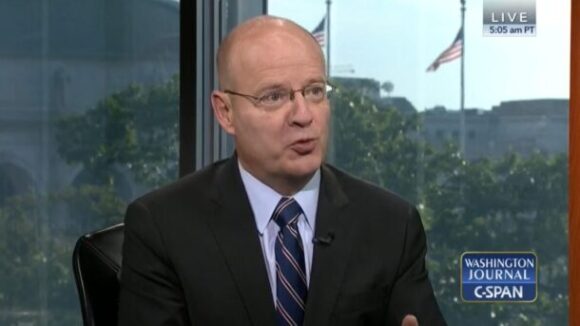Will Team Biden Weaponize Workers’ Pensions?
Big Labor abuse of worker pension and benefit funds as a means of advancing union bosses’ self-aggrandizing policy objectives is a familiar phenomenon.
Union Bosses Aim to Kill Recent Buckeye State Reform Next Month
(Source: October 2011 NRTWC Newsletter)
Over the past decade, the citizens of forced-unionism Ohio have been afflicted with one of the worst-performing state economies in the country.
Across the U.S. as a whole, despite the severe recent recession, private employers’ inflation-adjusted outlays for employee compensation (including wages, salaries, bonuses and benefits) did increase from 2000 to 2010, by an average of 4.3%.
And many states fared much better than that. In the 22 states with Right to Work laws on the books protecting both private- and public-sector employees from being fired for refusal to pay dues or fees to an unwanted union, real private-sector employee compensation grew by an aggregate 11.3%.
Private employees in 20 of the 22 Right to Work states experienced 2000-2010 compensation growth greater than the national average.
Unfortunately, in the 28 states without Right to Work laws on the books, private-sector outlays for employee compensation rose only by a combined 0.7%, after adjusting for inflation. Thirteen of the 14 states with the lowest compensation growth lack a Right to Work law.
Ohio was one of just five states with negative real private-sector compensation growth over the last decade. In 2010, Ohio’s business expenditures for private employee compensation were 6.6% less than they had been in 2000.
Region, Job Mix Can’t Account For Buckeye State’s Shrinking Private Employee Compensation
When confronted with such data, apologists for the forced-unionism policies that prevailed across the board in Ohio for decades until this year try to explain them away by blaming the Buckeye State’s location in the U.S. Midwest or its historically high manufacturing density for its abysmal economic record.
But such excuses won’t wash.
From 2000 to 2010, real private-sector employee compensation in the five Midwestern Right to Work states (Iowa, Kansas, Nebraska, North Dakota, and South Dakota) increased by an average of 11.5%. All five of these states enjoyed compensation growth greater than the national average.
In contrast, real private-sector compensation in Ohio and the six other Midwestern forced-unionism states (Illinois, Indiana, Michigan, Minnesota, Missouri and Wisconsin) fell by an aggregate 5.3%.
Moreover, a number of Right to Work states in which manufacturing’s share of total employment a decade ago was roughly equal to, or higher than, Ohio’s enjoyed above-average private-sector compensation growth over the past decade. Examples include Right to Work North Carolina, South Carolina and Tennessee.
Actions of Forced Dues-Funded Politicians Cripple Private-Sector Growth

“The evidence indicates it is the pro-forced union dues policies that have long been entrenched in Ohio, rather than any other factor, that are the source of the Buckeye State’s chronic economic woes,” charged Mark Mix, president of the National Right to Work Committee.
“Private-sector compulsory unionism and government forced unionism have both inflicted major damage on Ohio and many other states. But in recent years government union bosses have surely wrought the most harm of all. Today, most employees nationwide who are under union monopoly control are government employees.”
Mr. Mix explained: “Wherever union chiefs wield forced-dues powers, a huge portion of the loot they rake in goes into efforts to elect and reelect state and local, as well as federal, Big Labor politicians.
“Such politicians have a broad agenda that greatly impedes private-sector job and income growth.
“Fortunately, this spring two states enacted significant reforms that — if they withstand ongoing Big Labor-led attempts to remove them from the books — can begin undoing the damage over the course of the next few years.
“Ohio’s new public-sector Right to Work law, still often referred to as Senate Bill 5, includes provisions protecting the Right to Work of all categories of state and local employees. S.B.5 also reduces the scope of government union bosses’ monopoly-bargaining privileges in several other ways.
“S.B.5 is more comprehensive than the other state public-sector Right to Work law enacted in March, Wisconsin’s Budget Repair Act.
“The Badger State law protects the freedom of teachers and many other public employees to refuse to bankroll an unwanted union, but leaves untouched the forced-dues privileges of public-safety and public-transportation union bosses.”
National Right to Work Helped Mobilize Public Support For Reforms
“Grass-roots support for the public-sector Right to Work measures in Ohio and in Wisconsin was mobilized, in significant part, by the Committee’s e-mail and telecommunications activities,” Mr. Mix noted.
“Both these laws represent important advances for the Right to Work cause — especially the Ohio statute, because it protects all state and local employees from forced union dues. But both laws are also in danger of being reversed.”
The more immediate threat to Right to Work is in the Buckeye State.
During the spring and early summer, union strategists successfully collected the number of signed petitions needed to block implementation of S.B.5 and put their forced-dues reinstatement referendum before voters on November 8.
In Wisconsin, a Big Labor-inspired court challenge that had kept the Budget Repair Act in limbo for months was rebuffed by the state Supreme Court in June.
However, a second legal bid to invalidate the law, filed by lawyers representing a host of government unions, is now pending in federal court.
“The National Committee is offering our advice and counsel, as well as financial resources, to Ohio citizens who are battling to keep their new public-sector Right to Work law on the books,” said Mr. Mix.
“And in Wisconsin, National Right to Work Foundation attorneys have helped three public servants file a motion to intervene in the ongoing Big Labor lawsuit to overturn the Budget Repair Act.
“If the motion succeeds, these independent-minded employees will be able to present their own arguments to the court for why their Right to Work should continue to be legally protected.”
Big Labor Flooding Ohio Airwaves With Ads Designed To Confuse Electorate
As this month’s Right to Work Newsletter goes to press, national and state union bosses are spending millions of dollars, most of it derived from dues and fees employees are forced to pay as a job condition, to defeat Issue 2, the Ohio referendum that must pass if S.B.5 is to take effect and become permanent law.
“Union officials clearly know that the overwhelming majority of Ohioans support the principle that no one should be denied a job, or lose a job, because he or she refuses to pay dues or fees to an unwanted union,” commented Mr. Mix.
“Big Labor is also well aware of the fact that, in a state where, over the last decade, private-sector compensation has fallen by more than six percent, but state and local government compensation has increased by nearly 12%, voters know something must be done to restore the balance.
“That’s why the TV and radio ads with which the union hierarchy is now flooding the Ohio airwaves try to divert public attention from what S.B.5 would actually do and frighten people with talk about slashing school and public-safety budgets.
“The fact is, S.B.5 does not say anything about how much money the state of Ohio will dole out to local schools and police and fire departments in the future.
“It will, however, make it far less difficult for local elected officials to spend whatever money they have at their disposal prudently, so as to provide taxpayers good services at a reasonable cost. And it will protect each individual public servant’s freedom to join or not join a union.”
Mr. Mix vowed that the National Committee would throughout this month and over the first week in November contact hundreds of thousands of identified Right to Work supporters in Ohio to ensure that they understand what is at stake in Issue 2, and act accordingly.

Big Labor abuse of worker pension and benefit funds as a means of advancing union bosses’ self-aggrandizing policy objectives is a familiar phenomenon.

Leaked CTU Proposals Won’t Do Anything to Improve Schools’ Poor Performance

What impact does handing a union monopoly power to deal with your employer on matters concerning your pay, benefits, and work rules have on your pay?